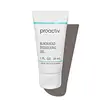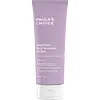What's inside
What's inside
 Key Ingredients
Key Ingredients

 Benefits
Benefits

 Concerns
Concerns

 Ingredients Side-by-side
Ingredients Side-by-side

Salicylic Acid 0.5%
MaskingAloe Barbadensis Leaf Juice
Skin ConditioningBisabolol
MaskingButyl Methoxydibenzoylmethane
UV AbsorberButyrospermum Parkii Butter
Skin ConditioningCamellia Sinensis Leaf Extract
AntimicrobialCaprylyl Glycol
EmollientCyclohexasiloxane
EmollientCyclopentasiloxane
EmollientDimethicone
EmollientDimethiconol
EmollientEthylhexyl Methoxycinnamate
UV AbsorberEthylhexyl Salicylate
UV AbsorberEthylhexylglycerin
Skin ConditioningParfum
MaskingGlycereth-26
HumectantGlycerin
HumectantHexylene Glycol
EmulsifyingLactic Acid
BufferingPanthenol
Skin ConditioningPEG-40 Hydrogenated Castor Oil
EmulsifyingPEG-80 Sorbitan Laurate
Phenoxyethanol
PreservativePolyacrylate-13
Polyisobutene
Polysorbate 20
EmulsifyingPPG-26-Buteth-26
Skin ConditioningWater
Skin ConditioningSalicylic Acid 0.5%, Aloe Barbadensis Leaf Juice, Bisabolol, Butyl Methoxydibenzoylmethane, Butyrospermum Parkii Butter, Camellia Sinensis Leaf Extract, Caprylyl Glycol, Cyclohexasiloxane, Cyclopentasiloxane, Dimethicone, Dimethiconol, Ethylhexyl Methoxycinnamate, Ethylhexyl Salicylate, Ethylhexylglycerin, Parfum, Glycereth-26, Glycerin, Hexylene Glycol, Lactic Acid, Panthenol, PEG-40 Hydrogenated Castor Oil, PEG-80 Sorbitan Laurate, Phenoxyethanol, Polyacrylate-13, Polyisobutene, Polysorbate 20, PPG-26-Buteth-26, Water
Water
Skin ConditioningButylene Glycol
HumectantCetyl Alcohol
EmollientPPG-14 Butyl Ether
Skin ConditioningSalicylic Acid
MaskingDimethicone
EmollientTocopheryl Acetate
AntioxidantChamomilla Recutita Flower Extract
MaskingEpilobium Angustifolium Extract
Skin ConditioningCamellia Oleifera Leaf Extract
AstringentVanilla Planifolia Fruit Extract
Skin ConditioningBisabolol
MaskingAllantoin
Skin ConditioningCyclopentasiloxane
EmollientCyclohexasiloxane
EmollientDimethiconol
EmollientPEG-40 Stearate
EmulsifyingSorbitan Stearate
EmulsifyingPvm/Ma Decadiene Crosspolymer
Polyacrylamide
C13-14 Isoparaffin
EmollientLaureth-7
EmulsifyingDisodium EDTA
Sodium Hydroxide
BufferingHexylene Glycol
EmulsifyingCaprylyl Glycol
EmollientCaprylic/Capric Triglyceride
MaskingEthylhexylglycerin
Skin ConditioningPhenoxyethanol
PreservativeWater, Butylene Glycol, Cetyl Alcohol, PPG-14 Butyl Ether, Salicylic Acid, Dimethicone, Tocopheryl Acetate, Chamomilla Recutita Flower Extract, Epilobium Angustifolium Extract, Camellia Oleifera Leaf Extract, Vanilla Planifolia Fruit Extract, Bisabolol, Allantoin, Cyclopentasiloxane, Cyclohexasiloxane, Dimethiconol, PEG-40 Stearate, Sorbitan Stearate, Pvm/Ma Decadiene Crosspolymer, Polyacrylamide, C13-14 Isoparaffin, Laureth-7, Disodium EDTA, Sodium Hydroxide, Hexylene Glycol, Caprylyl Glycol, Caprylic/Capric Triglyceride, Ethylhexylglycerin, Phenoxyethanol
 Reviews
Reviews

Ingredients Explained
These ingredients are found in both products.
Ingredients higher up in an ingredient list are typically present in a larger amount.
Bisabolol is famous for its skin soothing properties. It does this by blocking inflammatory signals, helping to reduce your body's reaction to irritation.
This ingredient also interferes with the process of hyperpigmentation. This can help with reducing dark spots and uneven tone.
Bisabolol is an antioxidant. Antioxidants help fight free-radicals. Free-radicals are molecules that may damage your skin cells. By fighting these free-radicals, Bisabolol may slow down signs of aging.
Studies have shown Bisabolol to have antimicrobial properties and may be a fungicide. These properties help preserve a product's shelf life.
All these properties makes bisabolol a great skin barrier helper ingredient.
Bisabolol also helps the absorption of other ingredients.
Note: Synthetic Bisabolol has been shown to be less effective.
Learn more about BisabololCaprylyl Glycol is a humectant and emollient, meaning it attracts and preserves moisture.
It is a common ingredient in many products, especially those designed to hydrate skin. The primary benefits are retaining moisture, skin softening, and promoting a healthy skin barrier.
Though Caprylyl Glycol is an alcohol derived from fatty acids, it is not the kind that can dry out skin.
This ingredient is also used as a preservative to extend the life of products. It has slight antimicrobial properties.
Learn more about Caprylyl GlycolCyclohexasiloxane is a type of silicone more commonly known as D6. It is an emollient and solvent.
Cyclohexasiloxane is used to evenly distribute ingredients throughout the product. When applied to the skin, Cyclohexasiloxane evaporates and leaves behind a silky feel.
As an emollient, it can help the skin feel soft and hydrated. It is also used to reduce frizz in hair products.
Learn more about CyclohexasiloxaneCyclopentasiloxane, or D5, is a silicone used to improve texture of products and trap moisture.
D5 is considered lightweight and volatile. Volatile means it evaporates quickly after application. Once evaporated, D5 leaves a thin barrier that helps keep skin hydrated.
It is also an emollient. Emollients help soften the skin and prevent water loss. Silicones create a silky texture in products. D5 helps other ingredients become more spreadable.
Studies show D5 is safe to use in skincare products. We recommend speaking with a skincare professional if you have concerns.
Learn more about CyclopentasiloxaneDimethicone is a type of synthetic silicone created from natural materials such as quartz.
What it does:
Dimethicone comes in different viscosities:
Depending on the viscosity, dimethicone has different properties.
Ingredients lists don't always show which type is used, so we recommend reaching out to the brand if you have questions about the viscosity.
This ingredient is unlikely to cause irritation because it does not get absorbed into skin. However, people with silicone allergies should be careful about using this ingredient.
Note: Dimethicone may contribute to pilling. This is because it is not oil or water soluble, so pilling may occur when layered with products. When mixed with heavy oils in a formula, the outcome is also quite greasy.
Learn more about DimethiconeDimethiconol is a silicone that resembles the popular dimethicone. Like other silicones, it is an emollient. Emollients create a thin film on skin to prevent moisture from escaping.
This ingredient helps to create a silky texture and improve spreadability. Due to its high molecular weight and thickness, it is often combined with cyclopentasiloxane.
Ethylhexylglycerin (we can't pronounce this either) is commonly used as a preservative and skin softener. It is derived from glyceryl.
You might see Ethylhexylglycerin often paired with other preservatives such as phenoxyethanol. Ethylhexylglycerin has been found to increase the effectiveness of these other preservatives.
Hexylene Glycol is a surfactant. Glycols are a class of alcohols. Hexylene Glycol is a surfactant and emulsifier.
As a surfactant, Hexylene Glycol helps gather dirt and oil on your skin to be washed away.
As an emulsifier, Hexylene Glycol helps keep water and oil together. This prevents them from separating in a product. Hexylene Glycol also thins out the texture of a product by lessening viscosity.
Hexylene Glycol has a small molecular weight.
Learn more about Hexylene GlycolPhenoxyethanol is a preservative that has germicide, antimicrobial, and aromatic properties. Studies show that phenoxyethanol can prevent microbial growth. By itself, it has a scent that is similar to that of a rose.
It's often used in formulations along with Caprylyl Glycol to preserve the shelf life of products.
Salicylic Acid (also known as beta hydroxy acid or BHA) is a well-known ingredient for treating skin that struggles with acne and clogged pores. It exfoliates both the skin's surface and deep within the pores to help clear out buildup, control oil, and reduce inflammation.
Unlike AHAs (alpha hydroxy acids), salicylic acid is oil-soluble. This allows it to penetrate into pores which makes it especially effective for treating blackheads and preventing future breakouts.
Salicylic acid is also known for its soothing properties. It has a similar structure to aspirin and can calm inflamed or irritated skin, making it a good option for acne-prone skin that is also sensitive.
Concentrations of 0.5-2% are recognized by the U.S. FDA as an over-the-counter topical acne product.
It can cause irritation and/or dryness if one's skin already has a compromised moisture barrier, so it's best to focus on repairing that before introducing this ingredient into your routine.
While salicylic acid does not increase sun sensitivity, it’s still important to wear sunscreen daily to protect your skin.
If you are looking for the ingredient called BHA or Butylated Hydroxyanisole, click here.
Learn more about Salicylic AcidWater. It's the most common cosmetic ingredient of all. You'll usually see it at the top of ingredient lists, meaning that it makes up the largest part of the product.
So why is it so popular? Water most often acts as a solvent - this means that it helps dissolve other ingredients into the formulation.
You'll also recognize water as that liquid we all need to stay alive. If you see this, drink a glass of water. Stay hydrated!
Learn more about Water